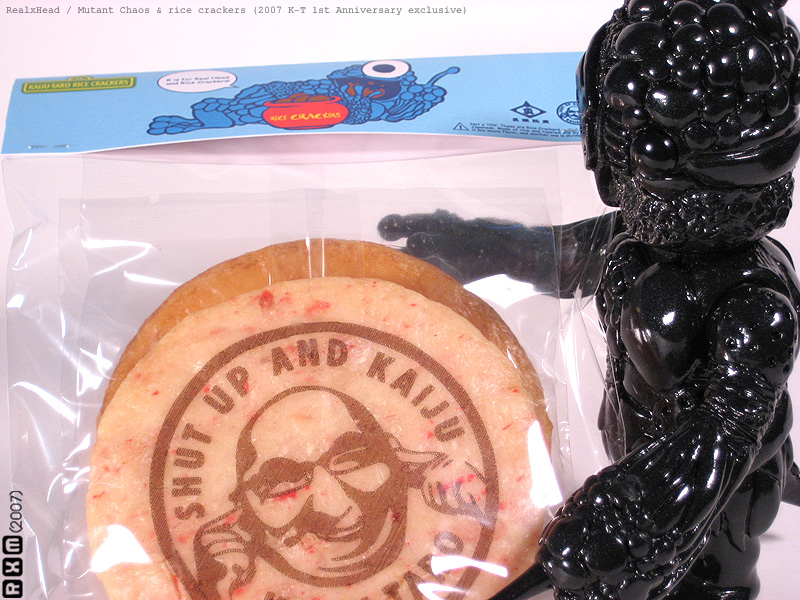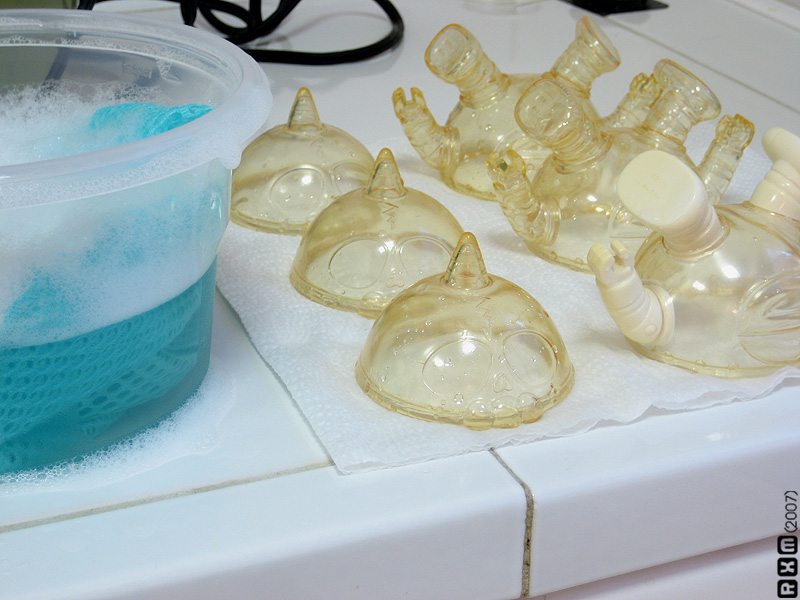skip to main |
skip to sidebar
 The Rumble Monsters hand-paint was just the tip of the iceberg! The bulk of Max Toy Co. collaborative releases in recent months have been with Japan architect-turned-toymaker Koiwa Naoki, better known to us as Cronic. Wave one was pre-sold in May via Max Toy Club (and sold out very quickly!) and consisted of a clear painted and unpainted Maverasu, as well as a painted Dorogami. Wave two was released at SDCC 2007, and was made up of green painted and unpainted Dorogami, a clear blue painted and unpainted Dorome, and finally, a spectacular clear rainbow-painted Nougaki! And as a final hurrah, Cronic released a sweet GID Bakurasu with sienna spray at Toy Karma. Considering that Koiwa-san still paints each of his pieces by hand, it makes one wonder how he kept up with his 'real life' job. Keep in mind that he was still putting out festival releases all the while.
The Rumble Monsters hand-paint was just the tip of the iceberg! The bulk of Max Toy Co. collaborative releases in recent months have been with Japan architect-turned-toymaker Koiwa Naoki, better known to us as Cronic. Wave one was pre-sold in May via Max Toy Club (and sold out very quickly!) and consisted of a clear painted and unpainted Maverasu, as well as a painted Dorogami. Wave two was released at SDCC 2007, and was made up of green painted and unpainted Dorogami, a clear blue painted and unpainted Dorome, and finally, a spectacular clear rainbow-painted Nougaki! And as a final hurrah, Cronic released a sweet GID Bakurasu with sienna spray at Toy Karma. Considering that Koiwa-san still paints each of his pieces by hand, it makes one wonder how he kept up with his 'real life' job. Keep in mind that he was still putting out festival releases all the while.
From the first wave of Cronic x Max Toy Co. releases, I picked up both the unpainted and painted clear Maverasu..ses. There's actually a bit of a story to this. After seeing the GID Balbagon and hearing that a Cronic exclusive was on the way, I joined the Max Toy Club just a few days prior to the preorder for the Cronic pieces was distributed. Unfortunately, circumstances led to me being omitted from the preorder list as a new member, and sending a gripey e-mail to Mark Nagata regarding the preorder. Well, that last part was all me, really. But fortunately, being the nice guy that he is, Nagata sent me the preorder as well and I managed to pick up one of the last few painted Maverasi. So how did I get the unpainted Maverasu you might ask? Well, Pinky, the same way I get most of my stuff- from the boards. And so, the two sailed their way across the Pacific to my apartment, and into the review queue.
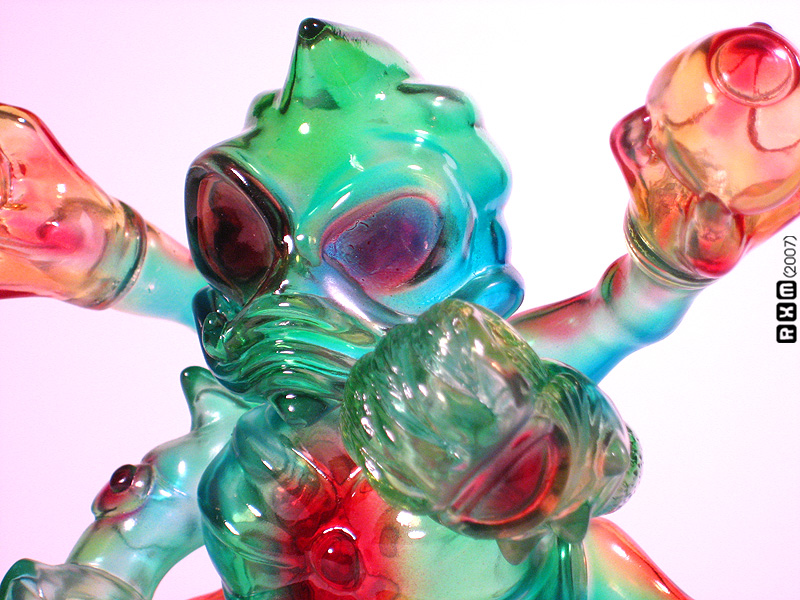
In my eyes, the MTC painted Maverasu is one of the finest colorways to be bestowed upon the sculpt. I do think that the original rainbow Maverasu- the "Illusion E" version- trumps this one, but only very slightly. Perhaps I should limit that to only the clear Maverasusses, because there have been some incredible solid color combinations as well. Dubbed by some as the "tie-dye" Maverasu, and by consummate toy blogger, Toybotstudios (2000), as the "Haight Ashbury" version, there are only 66 of these beauties in existence. Because I was late to the party, I own number 62 of 66.
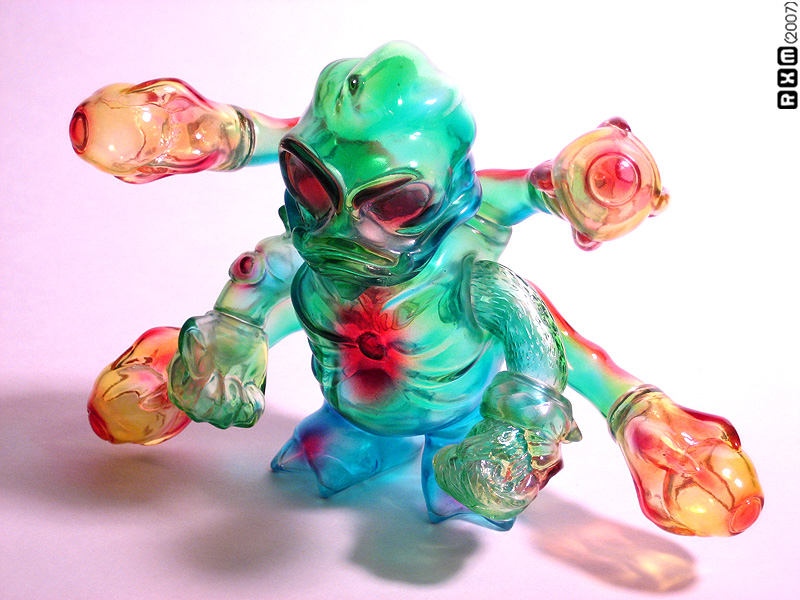 It's hard for me to verbalize exactly what makes this figure shine- I think in a sentence, it embodies everything that is good about Cronic's ability to combine otherwise dissimilar colors into a cohesive piece. Like a good kindergartener, every crayon in the box is used. I guess that might not really sound like a compliment. While a some have compared this to the ganja-and-patchouli-soaked hippie culture, the colors are reminiscent to me of a beautiful day in Hawaii. The smooth fade of blue-green into the electric blue in the feet resembles the color of the sea when it transitions from open ocean to shallower tidal waters. Red and yellow accents on the green base bring to mind tropical flowers in a lush, green garden. There is something ironic about the fact that I am sitting in my apartment on a beautiful day typing out overthought comparisons of a toy to the scenery outside my apartment. The light, it burns me. But we can't give all of the credit for this refreshing colorway to Koiwa-san; I understand that Nagata was the mastermind behind the color scheme. Great job, both of you.
It's hard for me to verbalize exactly what makes this figure shine- I think in a sentence, it embodies everything that is good about Cronic's ability to combine otherwise dissimilar colors into a cohesive piece. Like a good kindergartener, every crayon in the box is used. I guess that might not really sound like a compliment. While a some have compared this to the ganja-and-patchouli-soaked hippie culture, the colors are reminiscent to me of a beautiful day in Hawaii. The smooth fade of blue-green into the electric blue in the feet resembles the color of the sea when it transitions from open ocean to shallower tidal waters. Red and yellow accents on the green base bring to mind tropical flowers in a lush, green garden. There is something ironic about the fact that I am sitting in my apartment on a beautiful day typing out overthought comparisons of a toy to the scenery outside my apartment. The light, it burns me. But we can't give all of the credit for this refreshing colorway to Koiwa-san; I understand that Nagata was the mastermind behind the color scheme. Great job, both of you.
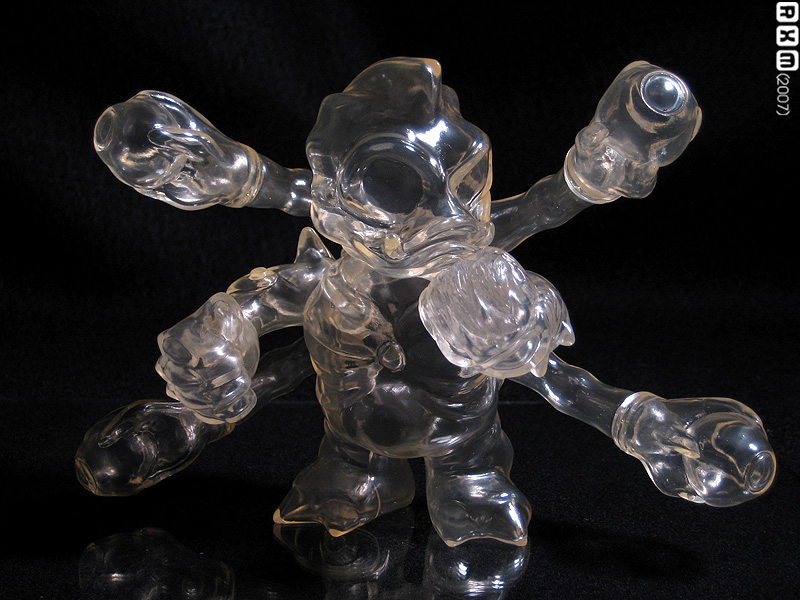 And as with most Max Toy Club releases, a limited number of toys are sold in all of their simple, unpainted glory. In this case, Nagata released 34 clear Maverasuses upon the public in addition to the painted main run. For you mathe-masters, 34 + 66 = 100, which I assume made up the entire re-run of clear Mavs. A few of us were surprised, I think, at seeing another clear Maverasu instead of the expected clear turquoise version. Cronic himself released the original clear Maverasu way, way back when, so if you are collecting these, it might behoove you to be sure of which one is being sold. Or maybe you don't care.
And as with most Max Toy Club releases, a limited number of toys are sold in all of their simple, unpainted glory. In this case, Nagata released 34 clear Maverasuses upon the public in addition to the painted main run. For you mathe-masters, 34 + 66 = 100, which I assume made up the entire re-run of clear Mavs. A few of us were surprised, I think, at seeing another clear Maverasu instead of the expected clear turquoise version. Cronic himself released the original clear Maverasu way, way back when, so if you are collecting these, it might behoove you to be sure of which one is being sold. Or maybe you don't care.
Incidentally, I suspect that there are only 33 of these remaining. Not pointing any fingers.
While the unpainted clear might feel like something of a letdown after the visual lap-dance that is the 'tie-dye' Maverasu, I enjoy collecting blank clear and solid versions of my favorite sculpts. Sometimes I think that it is easy to hide flaws or gloss over the true beauty in a sculpt by using a certain paint job. Unpainted clears are particularly interesting because of the way the 'layers' in the vinyl interact with one another when looking through the piece.
Not to pat myself on the back, but I really like the way these photographs turned out. Against the black background, the clear Maverasu almost looks like a glass sculpture. Sort of classy-like. Pat pat.
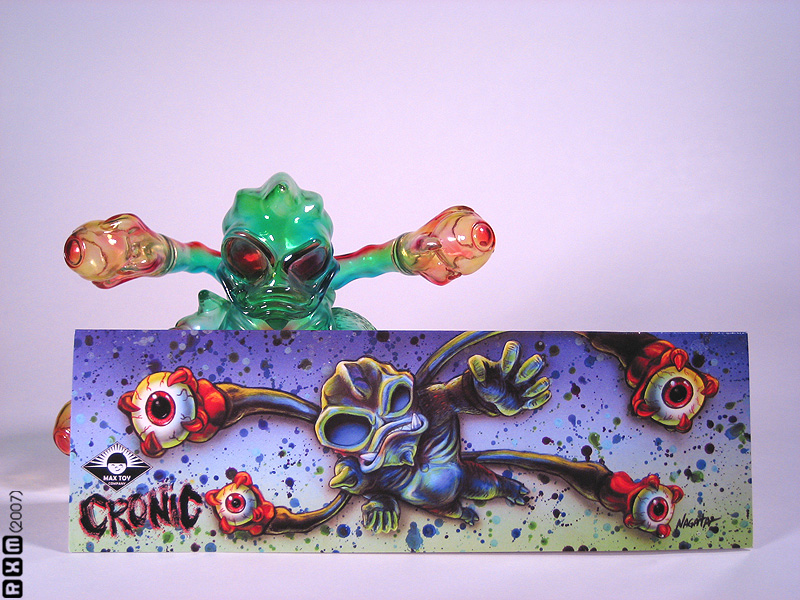 Oh, and there is some simply killer artwork on the header for this toy. Mark really brings the characters to life with his headers- check out the drawing for his latest Toy Club release, the Dream Rocket Gabari. Ninjas fighting a giant bug! (There are some of these still left unsold on the Max Toy Co. webstore as of the date of this post, so go get 'em!)
Oh, and there is some simply killer artwork on the header for this toy. Mark really brings the characters to life with his headers- check out the drawing for his latest Toy Club release, the Dream Rocket Gabari. Ninjas fighting a giant bug! (There are some of these still left unsold on the Max Toy Co. webstore as of the date of this post, so go get 'em!)
Also, if you are new to Cronic, be sure to check out Kaiju Korner, which is run by the man known as "andy."
That does it for Part II of Cronic Rumblings- check out the rest of your hard-earned photos:
Front and center:
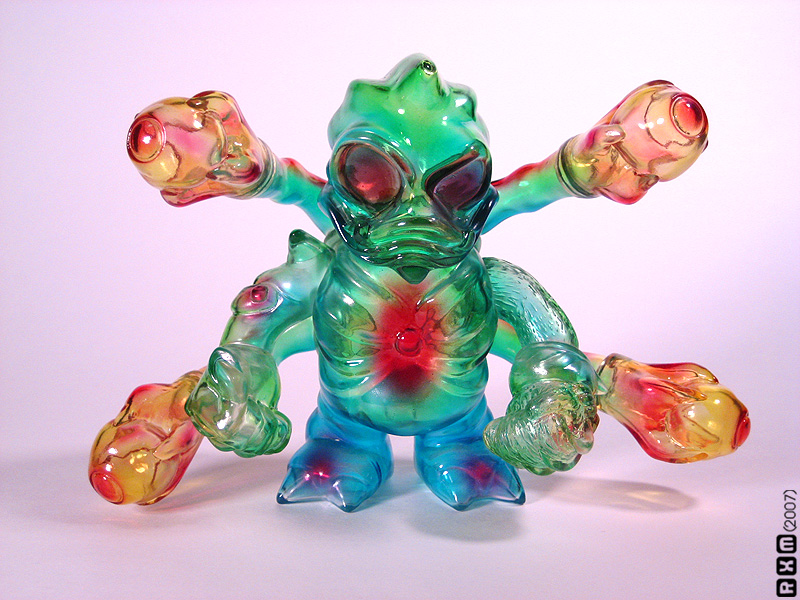 The obligatory backside shot:
The obligatory backside shot:
 Shot with stronger backlighting:
Shot with stronger backlighting: Older photo but I still like the way this toy looks in natural light:
Older photo but I still like the way this toy looks in natural light:
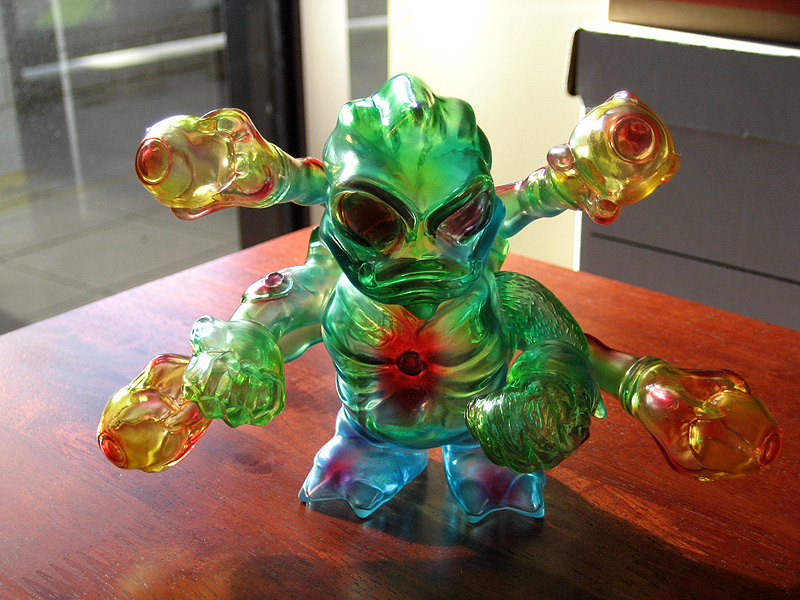 Clearly Maverasu:
Clearly Maverasu:
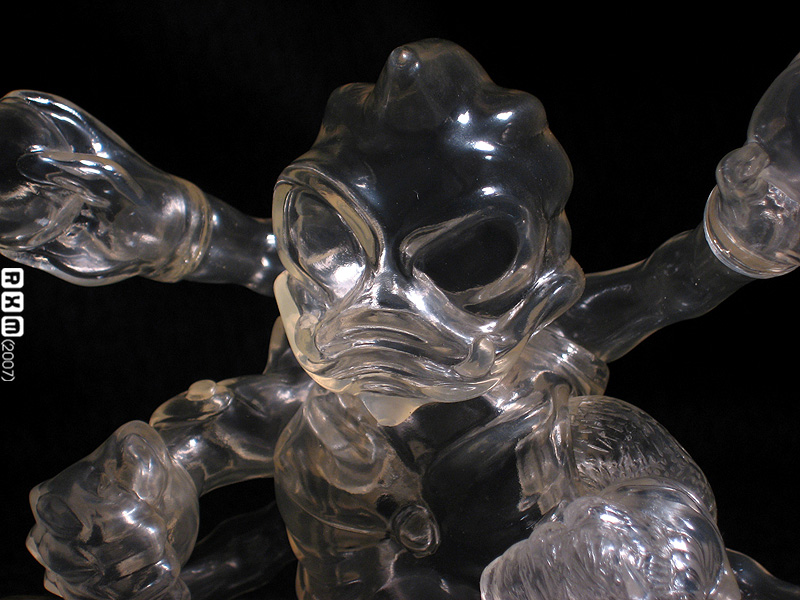
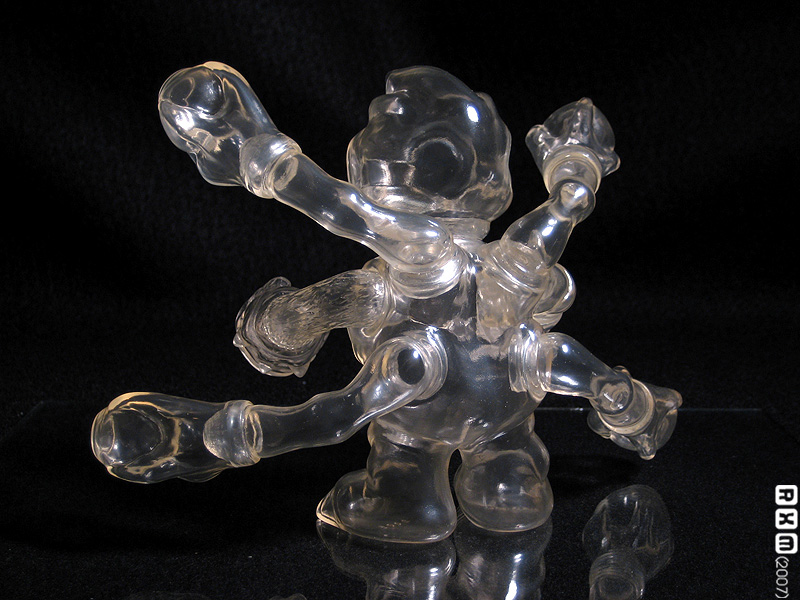
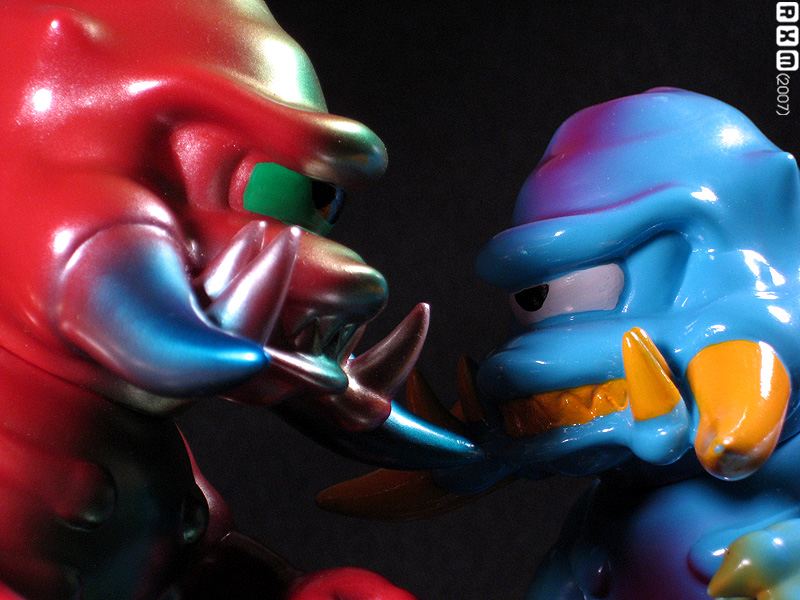 Mark Nagata has been a busy man in recent months, as the owner and operator of Max Toy Co. (among other occupations), releasing new collaborative works nearly every other month, it seems. This includes not only the periodic Max Toy Club (MTC) releases, but also a bevy of pieces sold at the San Diego Comic Con, and the exclusive items currently offered at the opening weekend of the "Toy Karma" exhibit in Chicago (technically, these are not Max Toy Co. collaborations, but Nagata is curating the exhibit).
Mark Nagata has been a busy man in recent months, as the owner and operator of Max Toy Co. (among other occupations), releasing new collaborative works nearly every other month, it seems. This includes not only the periodic Max Toy Club (MTC) releases, but also a bevy of pieces sold at the San Diego Comic Con, and the exclusive items currently offered at the opening weekend of the "Toy Karma" exhibit in Chicago (technically, these are not Max Toy Co. collaborations, but Nagata is curating the exhibit).
This week, we have part I of a three-part series of reviews, looking at a few of the recent Max Toy Co. releases, and other related items. Part I features The Rumble Monsters' 2007 collaborative release with Max Toy Co. and 2005 collaborative release with artist Rockin' Jelly Bean.
A long, long time ago- a long time in 'vinyl' years, that is- company Inazuma-Go began producing a line of soft vinyl toys under the name of "The Rumble Monsters" (TRM). One of its first characters was a burly, tusked dinosaur-like beast named "Pharaohs." From what I understand, the concept of the Pharaohs' design was a joint effort between Inazuma-Go and Rockin' Jelly Bean (interesting fact: RJB is responsible for the artwork in Velvet Revolver's music video for "Dirty Little Thing"; in fact, if you watch carefully, you can see the Pharaohs pop up in the video). The first colorway was a dark green base with silver teeth/tusks, red nails and a yellow eye (dubbed [GL-GR]). This colorway would be replicated in a later 'reissue' [GL-GR'] which is nearly identical, sans a blob of spray on the tail spike. Believe it or not, people will pay very good money for that little blob of spray.
As one of its earlier releases, TRM put out a set of two Pharaohs as a limited release sold exclusively at Erostika's shop. The first, [RJB-Custom 1st], was sold in May 2005 and cast in vivid orange vinyl, with bright blue accents, gold tusks/teeth and a painted white eye. This version always reminds me of the later Thrash-Out Pharaohs, although the two look nothing alike side-by-side. The second, [RJB-Custom 2nd] (featured here) was sold in November 2005, and cast in robin's egg blue vinyl, with purple highlights, yellow tusks/teeth and a white eye. I have always suspected, though have not been able to confirm, that the two RJB-Custom Pharaohs were actually hand-painted by RJB himself. The apparently low production numbers, combined with the uneven look of the spray and paint on the teeth and eyes, suggest a hand-paint, but I could be wrong (and often am). Pretending that I bought a hand-paint helps to justify the amount I paid for it.
 I am probably, at best, a casual TRM collector, but the colors on the RJB Custom 2nd Pharaohs are outstanding. The combination of the blue vinyl and purple spray reminds me of those malted eggs sold by the carton at Easter, and all other manner of happy springtime things. I am always surprised at how compact the sculpt of the Pharaohs is when I hold it in my hands. On screen, it has the tendency to appear a bit chunky, but it is a very tight, if muscular, sculpt in person. Those really are two words that should not be used together in a sentence about toys. The vinyl is also very solid and glossy, which feels nice in my hands. OKAY. Moving on.
I am probably, at best, a casual TRM collector, but the colors on the RJB Custom 2nd Pharaohs are outstanding. The combination of the blue vinyl and purple spray reminds me of those malted eggs sold by the carton at Easter, and all other manner of happy springtime things. I am always surprised at how compact the sculpt of the Pharaohs is when I hold it in my hands. On screen, it has the tendency to appear a bit chunky, but it is a very tight, if muscular, sculpt in person. Those really are two words that should not be used together in a sentence about toys. The vinyl is also very solid and glossy, which feels nice in my hands. OKAY. Moving on.
In June of 2007, Max Toy Co. announced its first club exclusive collaboration with TRM: a red Pharaohs with iridescent sprays. I receive the e-mail on a slow, balmy afternoon and hesitate for a bit- red really isn't my color. But I am ultimately swept away by the moment- and perhaps the $30 I just forked over for my club membership- and I place my order for one of the Pharaohs.
One of the cool things about any MTC exclusive is the huge glossy header that tops off the toy. Although I forgot to photograph the header this time, you can see it on the Max's Brain blog- it features a drawing of the Sphinx (not the stoic character from 'Gone in 60 Seconds'- Sphinx like in Egypt) with a Pharaohs' head. Clever. Although Nagata is probably best known among toy circles for Max Toy Co. and his immense Ultraman collection, he also is an accomplished artist. His resume includes, in addition to toy-themed art (featured originally in Super7 magazine!), many notable examples of commercial work, ranging from the covers of R.L. Stine's Goosebumps series to the cardbacks for Batman toys. Batman toy card art! Surely that is ample qualification to illustrate sofubi headers.
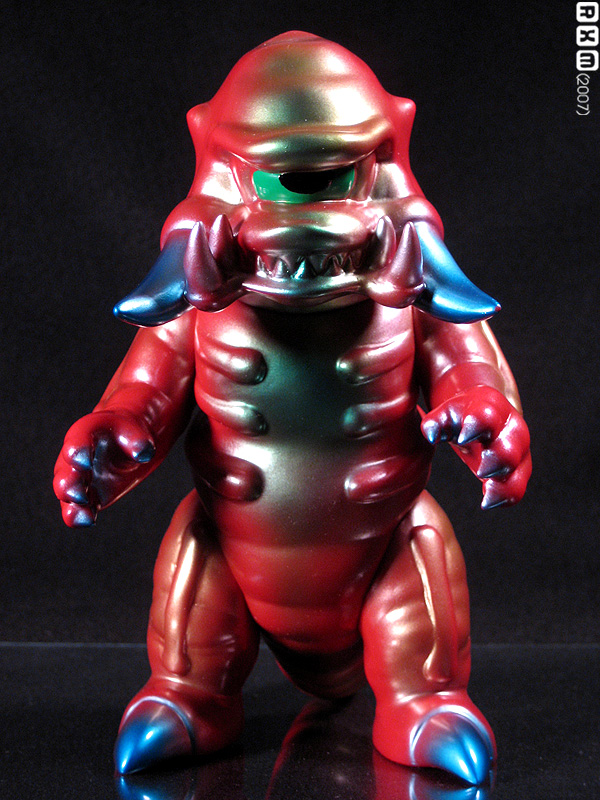 What then makes the MTC Pharaohs such an interesting toy is that every one of the 70 pieces sold was hand-sprayed by Nagata himself. Painstakingly so, if you read the extended account of the production process on geozilla's blog. There's just something indescribably awesome about owning a toy that was hand-painted by an artist. And this Pharaohs is really something special. As a perfect contrast to the bright blue RJB Custom Pharaohs, it is cast in a deep, peppery red. The iridescent sprays were layered by Nagata, who laid down golds and silvers first, and covered those with a metallic blue. The effect is a sort of an oily sheen- somewhat like the M1Go Pharaohs released a few months back- and plays off the traditional "Max Toy" colors well. The thing that makes this one a real keeper in my book, however, is the way it pairs up with the RJB Custom Pharaohs, which pairing is almost reminiscent of Tim Biskup's hot-and-cold Big Pollards.
What then makes the MTC Pharaohs such an interesting toy is that every one of the 70 pieces sold was hand-sprayed by Nagata himself. Painstakingly so, if you read the extended account of the production process on geozilla's blog. There's just something indescribably awesome about owning a toy that was hand-painted by an artist. And this Pharaohs is really something special. As a perfect contrast to the bright blue RJB Custom Pharaohs, it is cast in a deep, peppery red. The iridescent sprays were layered by Nagata, who laid down golds and silvers first, and covered those with a metallic blue. The effect is a sort of an oily sheen- somewhat like the M1Go Pharaohs released a few months back- and plays off the traditional "Max Toy" colors well. The thing that makes this one a real keeper in my book, however, is the way it pairs up with the RJB Custom Pharaohs, which pairing is almost reminiscent of Tim Biskup's hot-and-cold Big Pollards.
And because you didn't come here to watch me wax poetic on the winning qualities of my toys- seriously guys, this is hard work- here are more pictures for your enjoyment!
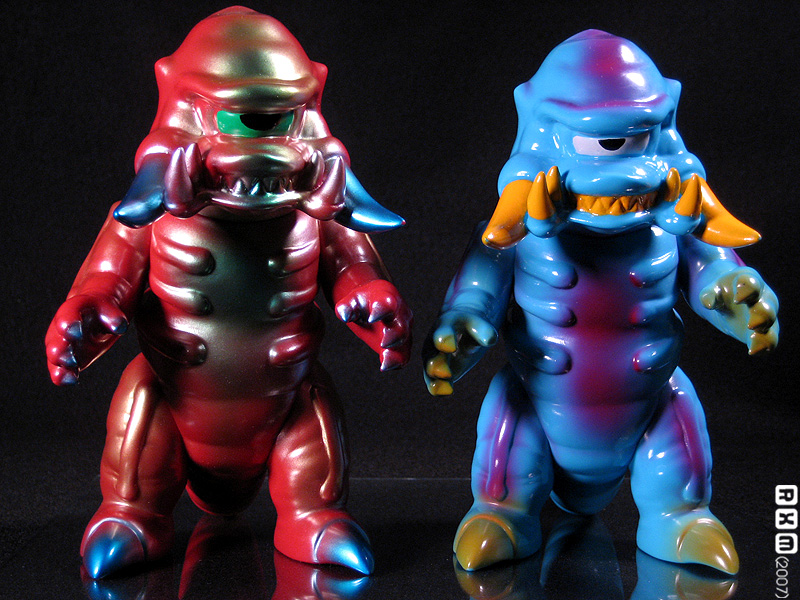
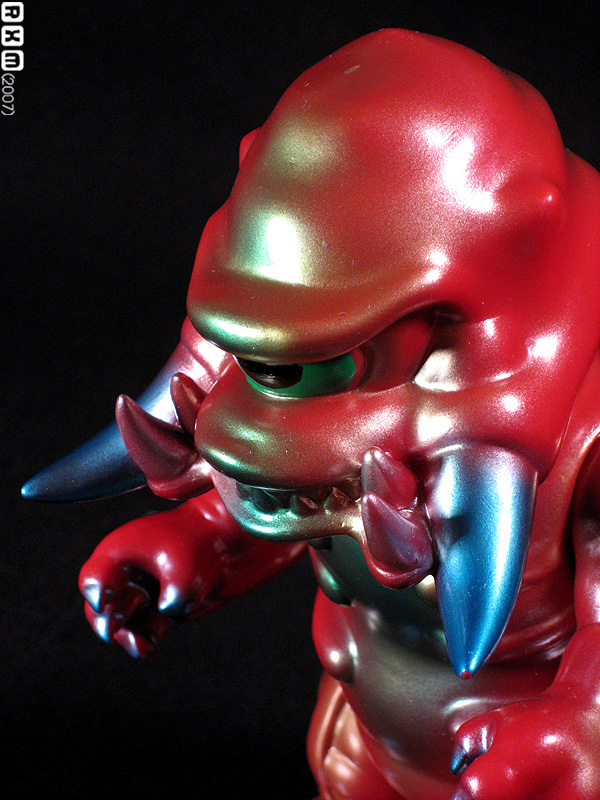
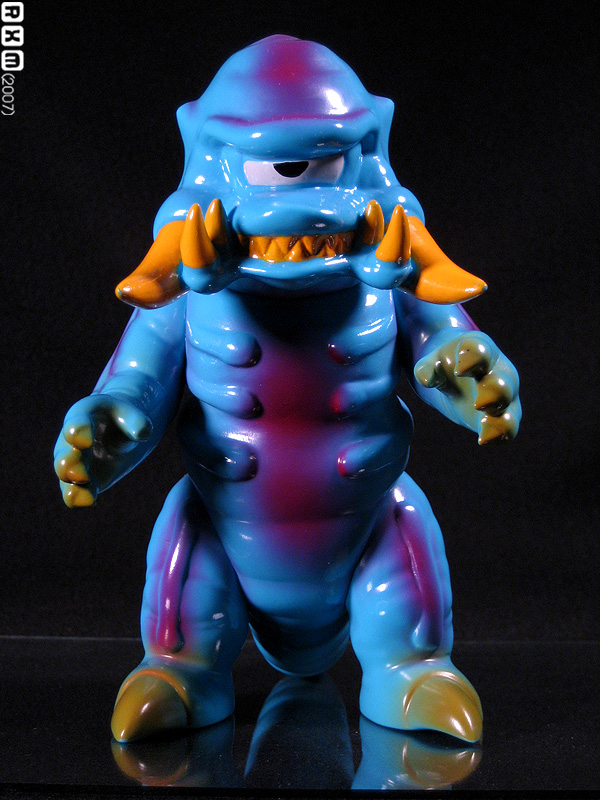
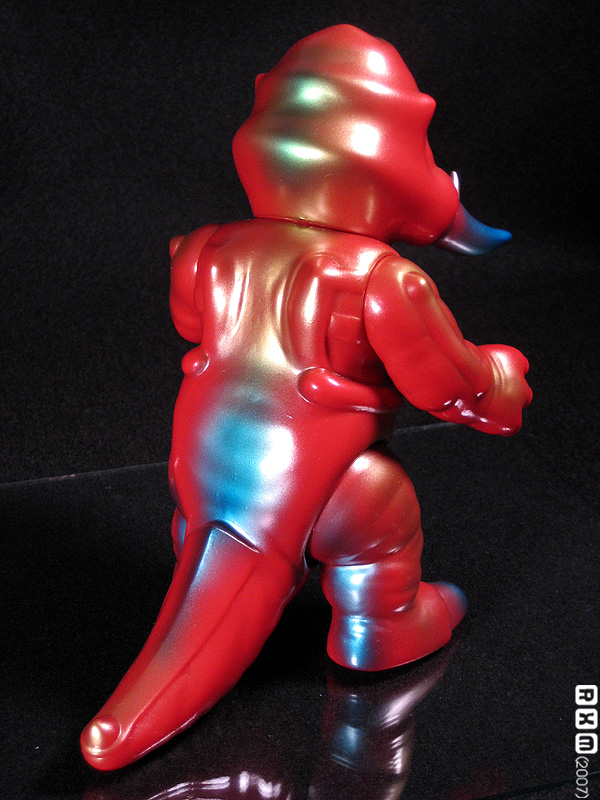
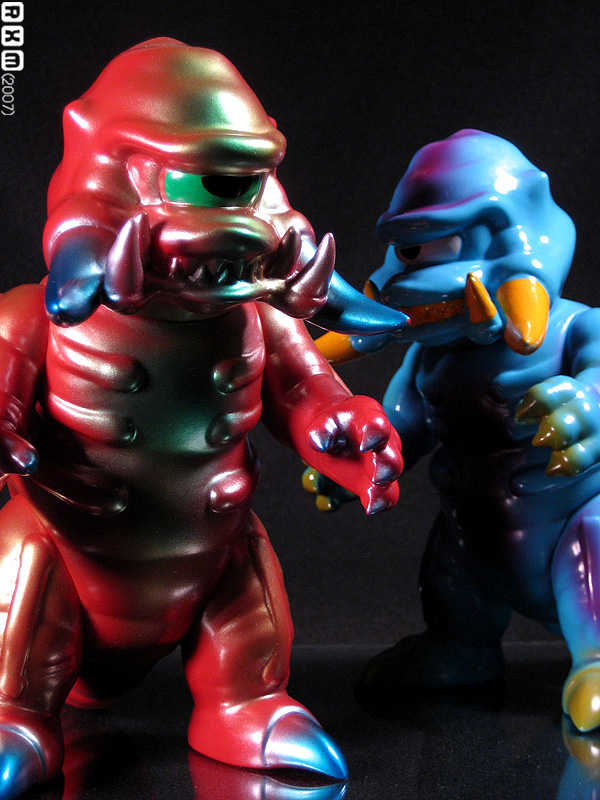

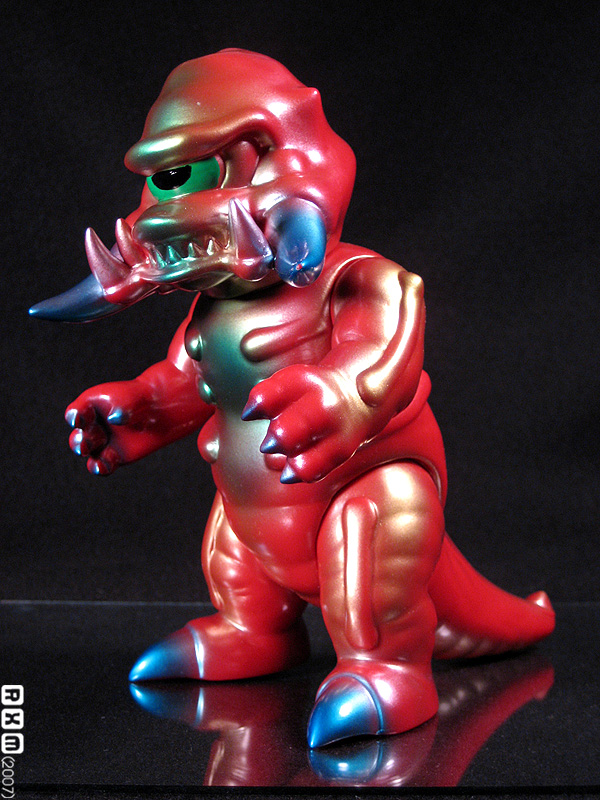

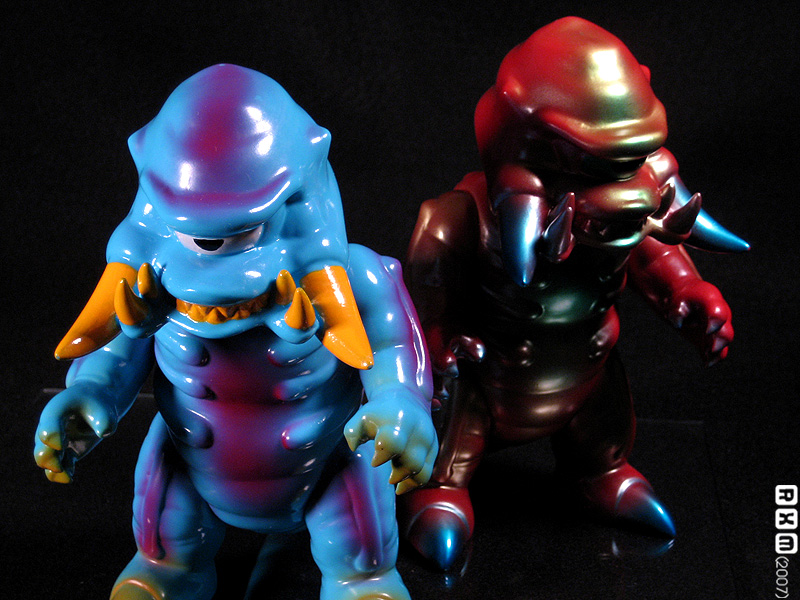
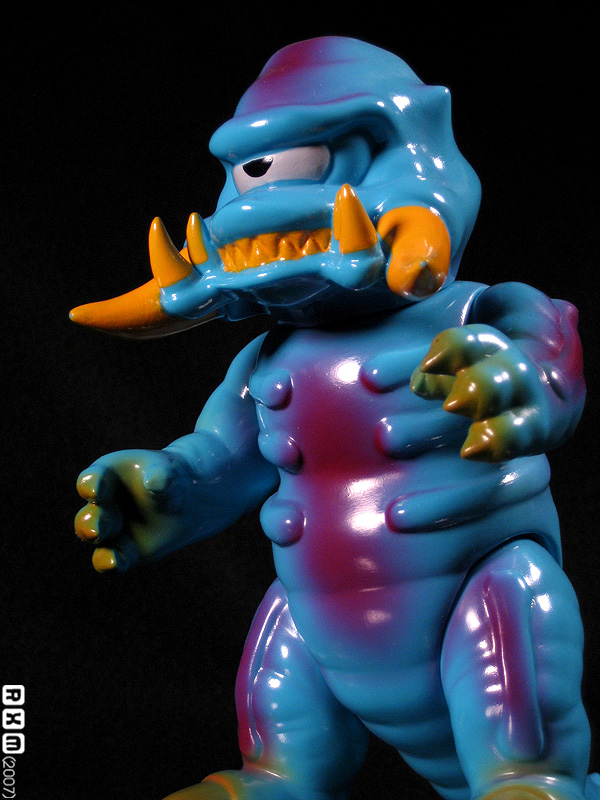
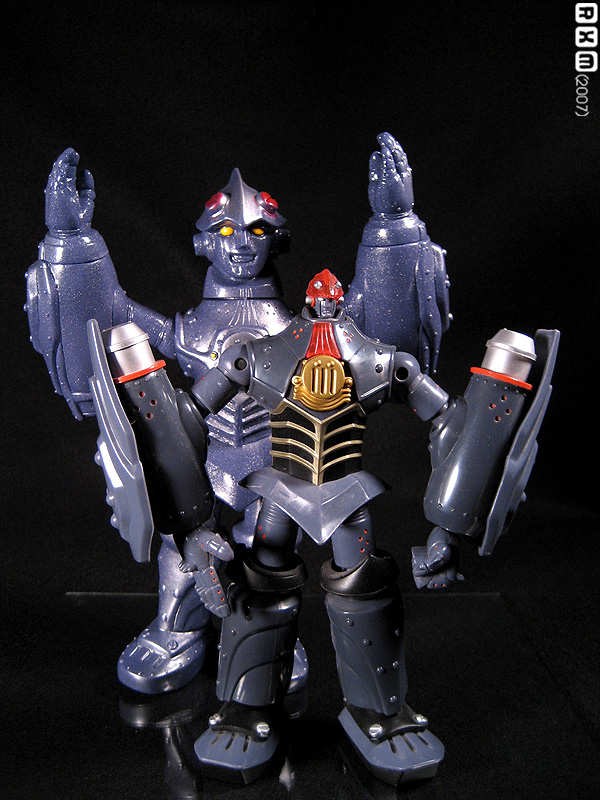 The Big O is an animated series consisting of 13 episodes, which originally ran in late 1999 in Japan before being imported and dubbed by Cartoon Network in 2001. The premise of the series involves a city (Paradigm City) whose inhabitants have all lost their memories due to a mysterious "event" in the past. Roger Smith is a negotiator for Paradigm City, who lives in a seeming penthouse in the center of the city, with his butler, Norman, and, later, befriended female android, Dorothy Wainwright. Oh, and he just happens to pilot an enormous robot- termed a 'Megadeuce'- named the Big O. This is probably a fairly important plot point. In the initial run of the series, only a portion of the plot touches on the event precipitating the current state of events in Paradigm City, many of the episodes have more of a typical super robot feeling to them, with Roger and the Big O battling various monsters and giant robots throughout the city- including sister Megadeuce, Big Duo, piloted by the madman Scwartzkopf (sp?).
The Big O is an animated series consisting of 13 episodes, which originally ran in late 1999 in Japan before being imported and dubbed by Cartoon Network in 2001. The premise of the series involves a city (Paradigm City) whose inhabitants have all lost their memories due to a mysterious "event" in the past. Roger Smith is a negotiator for Paradigm City, who lives in a seeming penthouse in the center of the city, with his butler, Norman, and, later, befriended female android, Dorothy Wainwright. Oh, and he just happens to pilot an enormous robot- termed a 'Megadeuce'- named the Big O. This is probably a fairly important plot point. In the initial run of the series, only a portion of the plot touches on the event precipitating the current state of events in Paradigm City, many of the episodes have more of a typical super robot feeling to them, with Roger and the Big O battling various monsters and giant robots throughout the city- including sister Megadeuce, Big Duo, piloted by the madman Scwartzkopf (sp?).
In the second run of 13 episodes, which aired, interestingly, due to popular demand from overseas, there was much greater exploration of the history of the city, Roger and the Big O. This second run came in 2003 for both Japanese and American audiences. In some ways, I think, the second run was much more cohesive in terms of a strong central plot, whereas the first run sort of meandered through various battles, alighting only briefly upon the 'historical' aspect of the show. Although anyone who has watched all 26 episodes will know that the ending definitely leaves something to be desired.
The Big O was definitely a deviation from typical Japanese mecha fare, which increasingly seems to consist of the teenagers-in-robots genre. The atmosphere of the series has been compared to the film noir genre; for those of us less-cultured viewers, you will probably notice similarities to the old Batman animated series from the early 90s. Roger Smith, does, in fact, bear numerous similarities to billionaire playboy, Bruce Wayne, not the least of which are his love of black clothing and cavernous underground lair. The music of the series is also incredible, ranging from a jazzy piano score as Roger drives through the city, to a symphonic synthesizer-and-brass track for the fight scenes. While it took me a while to warm up to the unusual style of The Big O, the starkly beautiful animation and varied, but heavily piano-based, soundtrack have made this one of my favorite animated series of all time, and definitely one of the most unique.
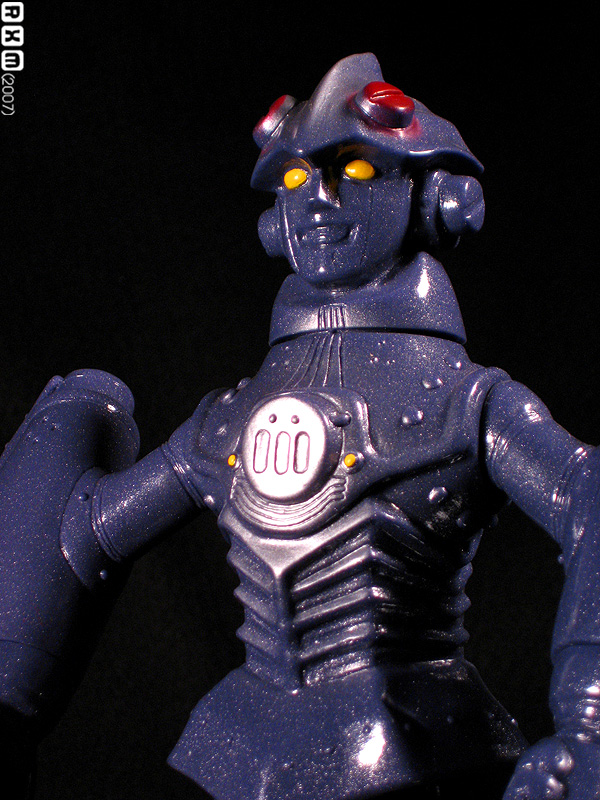 And yes, as with any good Japanese anime, there were toys. Surprisingly, there were actually very few toys produced. The best known are probably the imported Anime Collectors versions of the Big O and Big Duo; I bought the Big O back when the series first debuted in the U.S., and regrettably passed on the Duo. The Big O goes for a fair price nowadays, and the Duo is all but impossible to find. A couple of resin kits were also produced, most likely as exclusives for various toy shows. Kotobukiya also put out a series of trading figures more recently, which were probably intended to coincide with the 2nd run of the show. There is a 30 cm version of the Big O currently slated for a 2008 release by Max Factory under its Max Gokin line.
And yes, as with any good Japanese anime, there were toys. Surprisingly, there were actually very few toys produced. The best known are probably the imported Anime Collectors versions of the Big O and Big Duo; I bought the Big O back when the series first debuted in the U.S., and regrettably passed on the Duo. The Big O goes for a fair price nowadays, and the Duo is all but impossible to find. A couple of resin kits were also produced, most likely as exclusives for various toy shows. Kotobukiya also put out a series of trading figures more recently, which were probably intended to coincide with the 2nd run of the show. There is a 30 cm version of the Big O currently slated for a 2008 release by Max Factory under its Max Gokin line.
 But I had no idea that a soft vinyl version of the Big O had ever been produced, until I came across it a couple of weeks ago at the Super 7 webstore. A Big O sofubi- how could I not have known about this?? When I found it, my palms instantly became sweaty, and I quickly punched my shipping and payment information in, and the Megadeuce was mine! Being curious as to how I overlooked this little piece of heaven, I e-mailed one of the staff to inquire as to the origin of this toy (and, of course, if any more like it could be acquired). Unfortunately, they did not know anything more than I did. However, upon a little research at the ToyboxDX archives, it appears that sofubi Big O was released by Bear Model at roughly the same time as the first run of the show in Japan. It does not seem that toys of any other of the characters were released by Bear Model, making this something of an anomaly. If anyone else has a lead on other sofubi Big O items, please feel free to let me know.
But I had no idea that a soft vinyl version of the Big O had ever been produced, until I came across it a couple of weeks ago at the Super 7 webstore. A Big O sofubi- how could I not have known about this?? When I found it, my palms instantly became sweaty, and I quickly punched my shipping and payment information in, and the Megadeuce was mine! Being curious as to how I overlooked this little piece of heaven, I e-mailed one of the staff to inquire as to the origin of this toy (and, of course, if any more like it could be acquired). Unfortunately, they did not know anything more than I did. However, upon a little research at the ToyboxDX archives, it appears that sofubi Big O was released by Bear Model at roughly the same time as the first run of the show in Japan. It does not seem that toys of any other of the characters were released by Bear Model, making this something of an anomaly. If anyone else has a lead on other sofubi Big O items, please feel free to let me know.
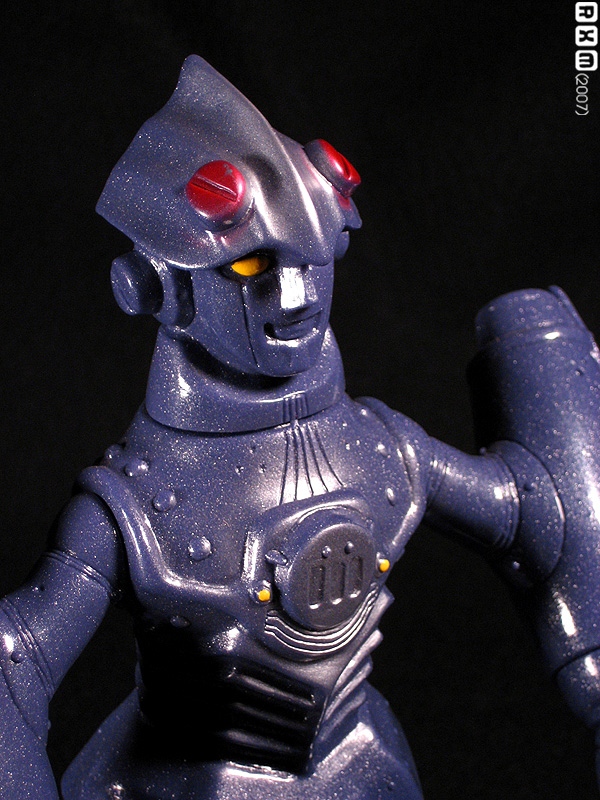 And the toy itself? Well, have you ever heard the phrase, "so bad, it's good"? The proportions of the Big O are almost comically incorrect, with a head that's nearly as large as its torso, and arms that are woefully short of the Popeye-esque dimensions of the animation model. The paint is barely there, with a smattering of silver spray on the head, torso and arms. As if it were intentional, the colors are reversed on the helmet, with the two 'knobs' painted red and the dome sprayed silver. One leg is even shorter than the other, but it stands... barely. And, I suppose, that is part of the toy's charm. Given that soft vinyl versions of modern mecha are all but unheard of, and knowing of the anomalous circumstances of this toy's creation, one might wonder whether it was purposefully done as a nod to the bootleg sofubi super robots of old- akin to Gargamel's Zokki Kaiju series of toys. Zokki Mecha?
And the toy itself? Well, have you ever heard the phrase, "so bad, it's good"? The proportions of the Big O are almost comically incorrect, with a head that's nearly as large as its torso, and arms that are woefully short of the Popeye-esque dimensions of the animation model. The paint is barely there, with a smattering of silver spray on the head, torso and arms. As if it were intentional, the colors are reversed on the helmet, with the two 'knobs' painted red and the dome sprayed silver. One leg is even shorter than the other, but it stands... barely. And, I suppose, that is part of the toy's charm. Given that soft vinyl versions of modern mecha are all but unheard of, and knowing of the anomalous circumstances of this toy's creation, one might wonder whether it was purposefully done as a nod to the bootleg sofubi super robots of old- akin to Gargamel's Zokki Kaiju series of toys. Zokki Mecha?
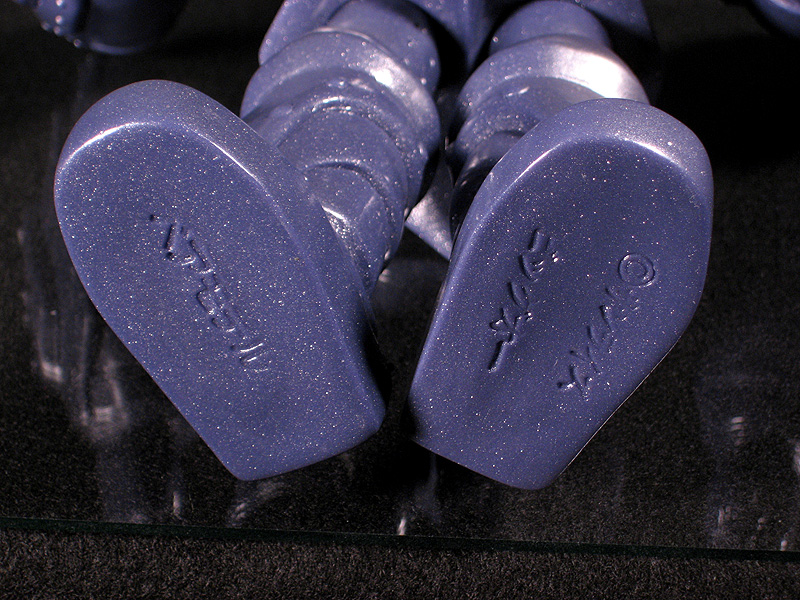 But there can be no doubt that this is a licensed item- the foot (and header, not shown) clearly bear the mark of Sunrise Studios. The concept of toys produced as a one-shot deal between the sofubi producer and the parent company is not unknown- for example, garage toymaker Sakamoto Showten produces his own line of Votoms sofubi toys at each Wonderfestival under a one-day license from Sunrise Studios, and Charactics probably does something similar with Takara in selling their Henshin Cyborg vinyl toys. Still, it is an oddity, but a welcome one at that.
But there can be no doubt that this is a licensed item- the foot (and header, not shown) clearly bear the mark of Sunrise Studios. The concept of toys produced as a one-shot deal between the sofubi producer and the parent company is not unknown- for example, garage toymaker Sakamoto Showten produces his own line of Votoms sofubi toys at each Wonderfestival under a one-day license from Sunrise Studios, and Charactics probably does something similar with Takara in selling their Henshin Cyborg vinyl toys. Still, it is an oddity, but a welcome one at that.
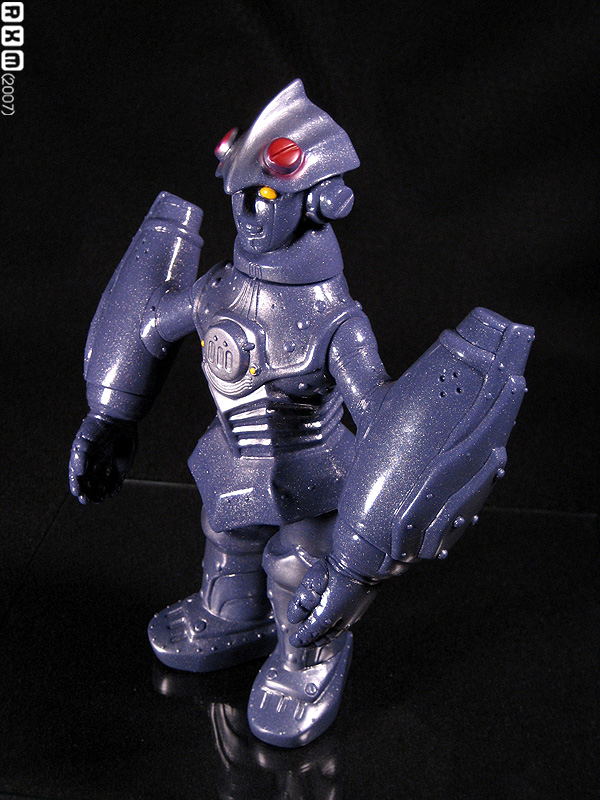 Misproportions aside, this is a solid toy, made of stiff vinyl with metallic flakes suspended in the material. A few rattly bits of flash (I assume) appear to be floating around in the body. All in all, 9 inches of standard-size neo-retro mecha vinyl, combined with a bargain price, make this one of my favorite purchases in recent months. I literally could not stop smiling when I opened the package, and would have started flying it around the room humming The Big O theme, if not for my girlfriend being present.
Misproportions aside, this is a solid toy, made of stiff vinyl with metallic flakes suspended in the material. A few rattly bits of flash (I assume) appear to be floating around in the body. All in all, 9 inches of standard-size neo-retro mecha vinyl, combined with a bargain price, make this one of my favorite purchases in recent months. I literally could not stop smiling when I opened the package, and would have started flying it around the room humming The Big O theme, if not for my girlfriend being present.
If you're looking for one of these, however, I wish you the best of luck. There is very little information on the Internet, and it appears that only 2 of these pieces have sold on Yahoo Japan Auctions over the past 2 years.
Additional photos:
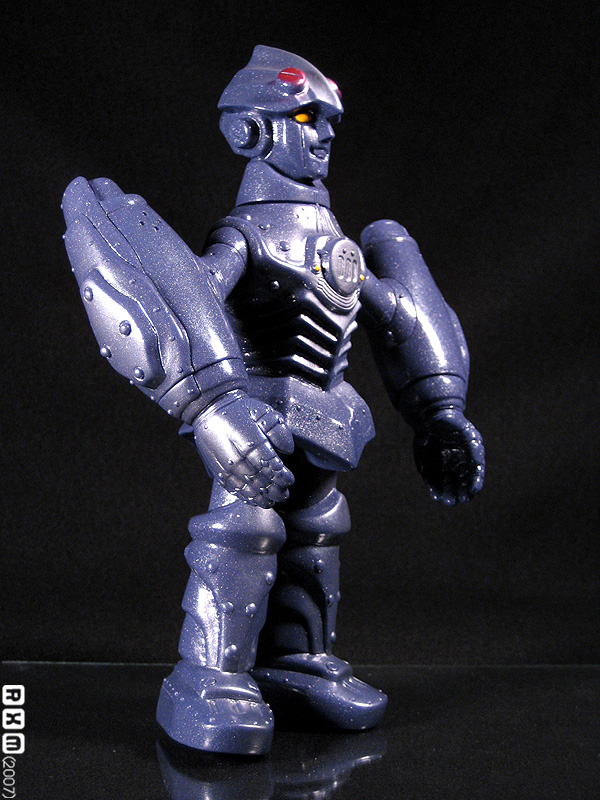 Front:
Front:
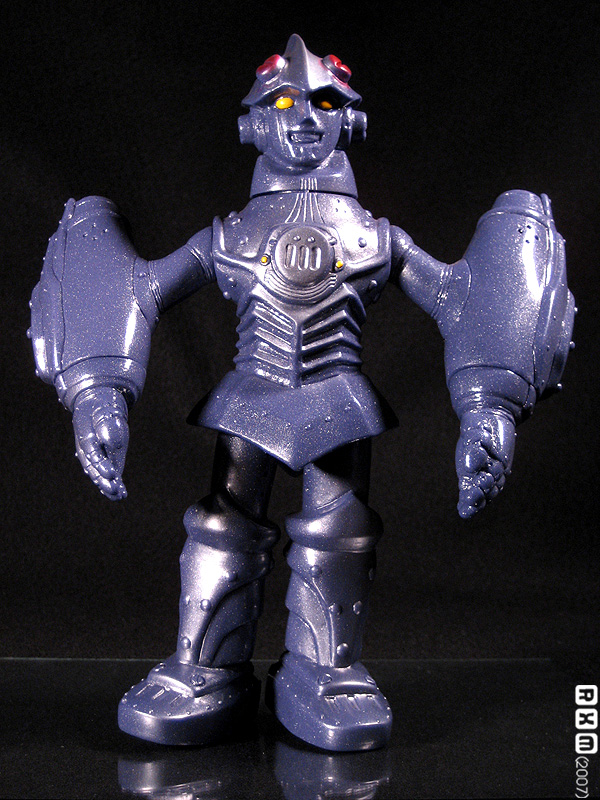 Side:
Side:
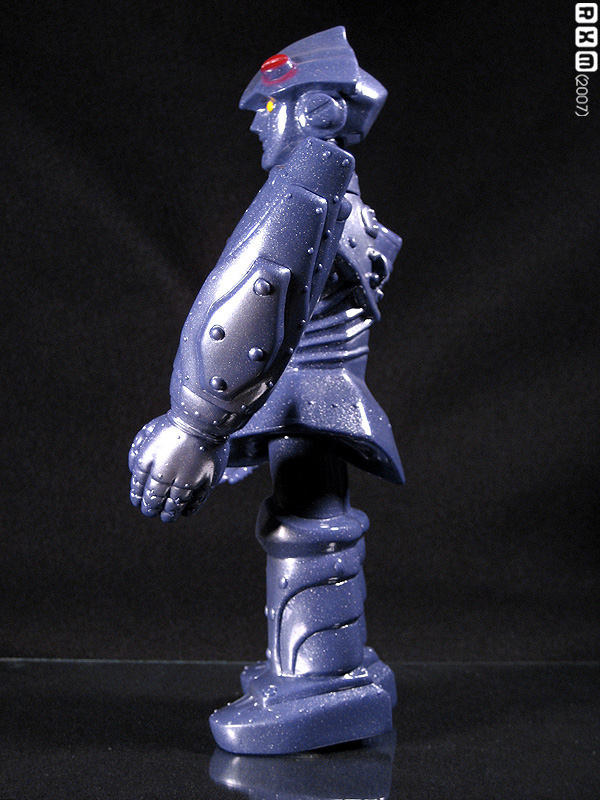 Back:
Back:
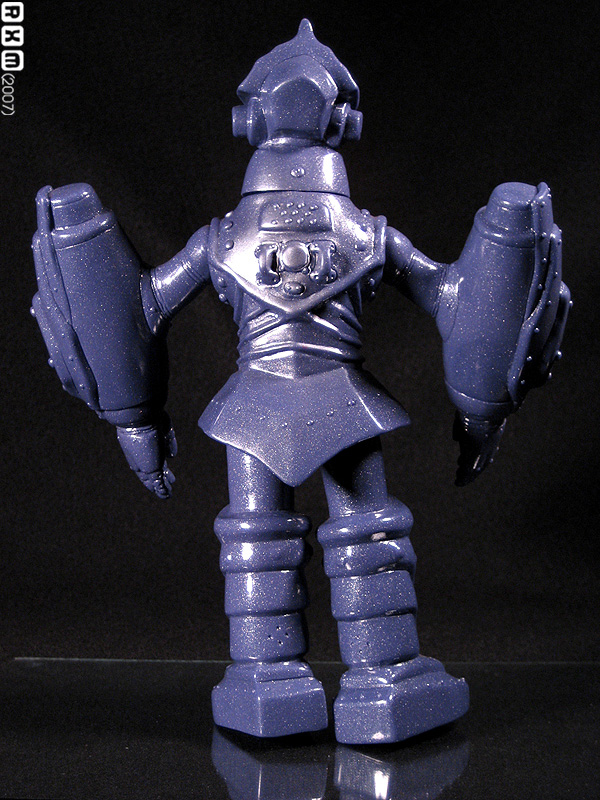 Face detail:
Face detail: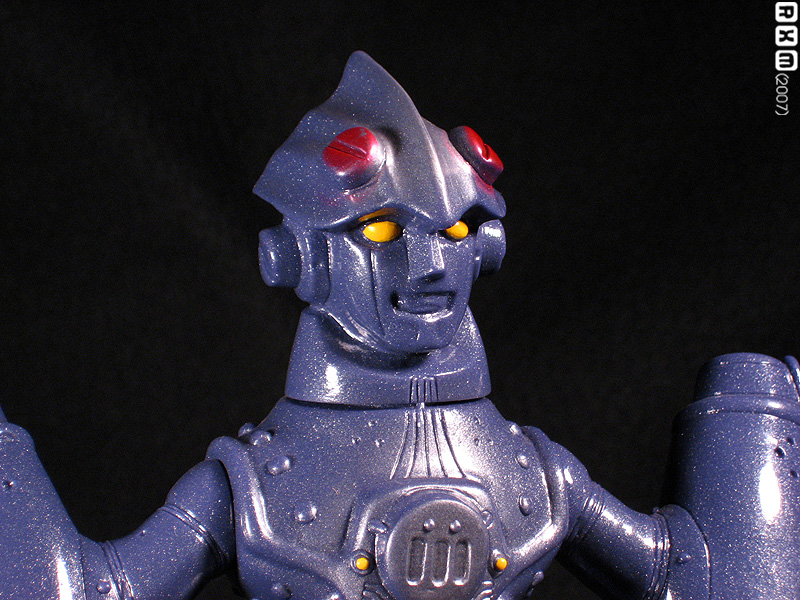 Chest front detail:
Chest front detail: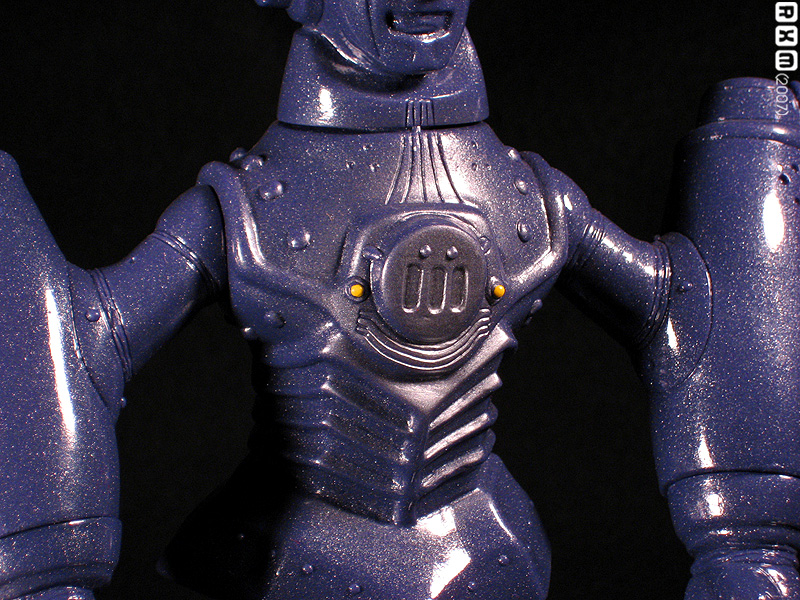 Chest back detail:
Chest back detail: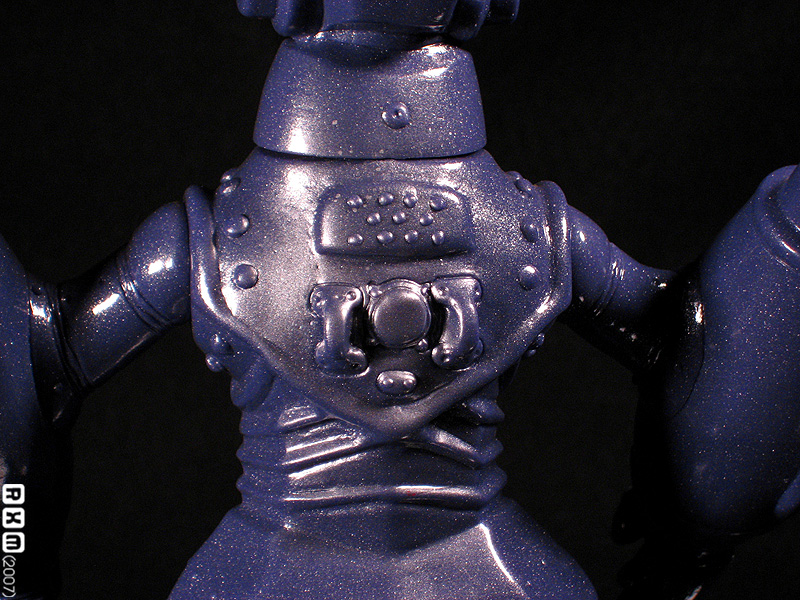 I think this is my favorite photo for unintentional hilarity. I originally intended to use it to compare the 'serious' Big O toy and the soft vinyl version, but it really just serves to showcase the big doofy grin on SofuBig O's face and the grumpy frown on the original's.
I think this is my favorite photo for unintentional hilarity. I originally intended to use it to compare the 'serious' Big O toy and the soft vinyl version, but it really just serves to showcase the big doofy grin on SofuBig O's face and the grumpy frown on the original's.
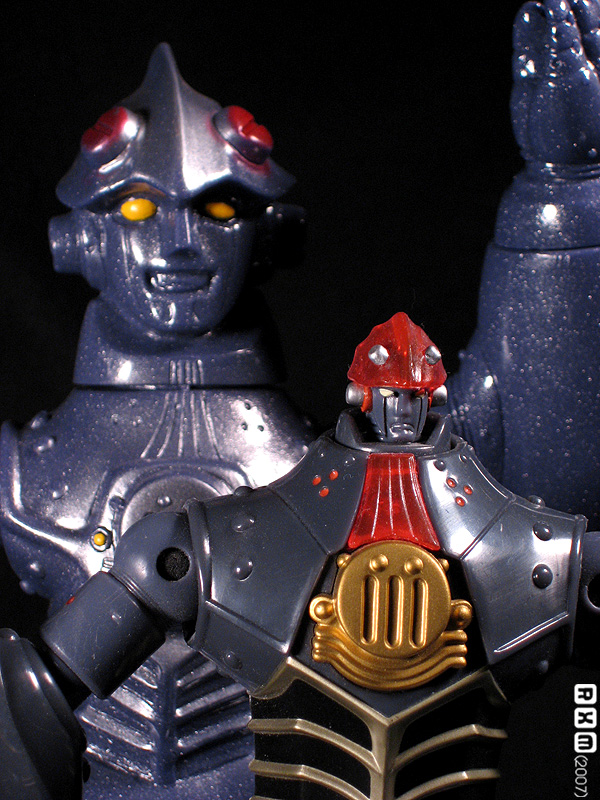 COMING NEXT??!??
COMING NEXT??!??


























